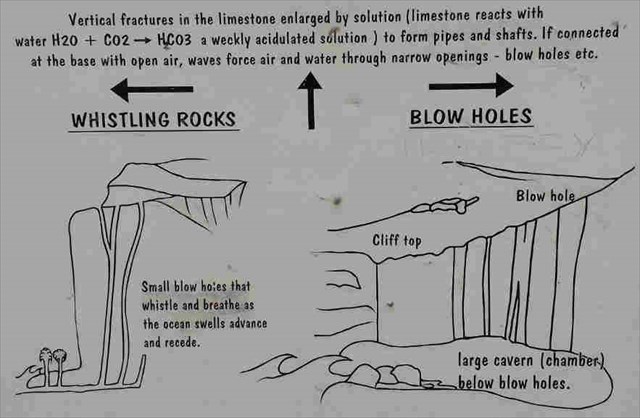Streaky Bay is a town located about 470 km north west of Adelaide, but to drive there you need to skirt around both Vincent Gulf and Spencer Gulf, and you're up for a drive of just under 700 km following the shortest route.
Once there the Cape Bauer scenic road is a loop north west of the town along the coast which takes you past some beautiful views of the interesting coastal features in the region.
These include this one, known as Whistling Rocks.
This area is on the edge of the Nullarbor Plain, the earth's largest piece of limestone (200 000 km2 and 1200 km from east to west at its furthest point).
Along the coast, this limestone slab is subject to both water erosion and wind erosion, and chemical changes as well. There are also physical impacts from the land movements that occur all over the earths surface.
The physical forces at play on such a large slab of limestone cause vertical cracks to appear in the slab, close to where the cliff edge has formed following the effects of wind and sea erosion.
These cracks and fissures are enlarged by the dissolving action of water, enhanced by being slightly acidic after having picked up carbon dioxide from chemical activity in the soil. The acidic water running down these fissures pools at the bottom, further dissolving the limestone to form horizontal drains and caves. If these caverns and drain holes below the fissures are exposed to waves and wind, you have the classic structure of a blowhole .

If the fissures and caverns are wide you get the loud and raucous noise of a blowhole, as waves compress and expel the air up the fissures. Where the tubes are narrow, the escaping air is more of a whistle, and since this is the situation here, the feature is called Whistling Rocks.
The best conditions are to be found at the higher tides, when an onshore wind is piling up the water and the waves dump it into the caverns below the tubes, forcing the maximum amount of air up the tubes.
To log a find on this earthcache, please carry out the following tasks to receive permission. You can log the find immediately, but such logs which are not followed up with answers will be deleted after a reasonable period of time, say two weeks, has elapsed.
1. Describe the conditions you are experiencing here today, in terms of wind and tide levels.
2. Describe what you can see and hear in relation to the geological feature existing here, and how this observation is linked to answer 1.
3. Please attach a photo to your Found Log, showing the view from GZ, with you or a personal item, included in the photo.
4. Please send your answers to me, preferably at earthcaches@jamieson.id.au which will usually get a faster response than sending via my profile.